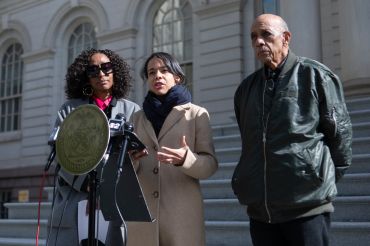The Sit-Down with Gene Kaufman: Recovery Blueprints
By Jotham Sederstrom May 17, 2010 5:17 pm
reprints
The Commercial Observer:
Hotel construction seems to be picking up. What do you attribute the activity to?
Mr. Kaufman: I think the main reason why it’s picked up, relative to everything else, has been more about the customer: who’s going to come and stay for one or two or three nights in a hotel and spend a few hundred dollars versus someone who’s going to buy a condominium apartment for hundreds of thousands or sign an office lease for millions. It’s fairly easy, even in an economy that hasn’t fully recovered, to become a hotel customer. So hotels have had a resurgence that hasn’t been matched by any other sector in the real estate community.
Is this an indicator that things are picking up all around in real estate?
I think it is. It’s not necessarily translating—or, will necessarily translate easily—into other fields, but I think that this is sort of like the first buds of spring. Spring is coming. And I think this is a sign of it.
As an architect, which kinds of projects are you seeing less of and what are you seeing more of?
There aren’t too many that there are more of. Hotels are relatively unique right now. I think you are seeing renovations of existing commercial space and renovations of existing owner-occupied residential by people who are doing this as a downscaling of what might have otherwise been a larger real estate investment move.
What you are not seeing are a lot of new projects of any other ilk other than hotels. Not residential condominiums, not other types of commercial development, and a very limited amount, but not a great deal, of institutional projects.
How has the recession affected your business, and architects in general?
Right now we are doing well, but, like everyone else, when the economy went down, everybody went down with it. The outburst of the rising tide lifting all the ships—when the tide went out, we got to see who was swimming naked. And I think everybody was somewhat exposed, some more and some less. I think some people have weathered this. Other people, unfortunately, have weathered it not very well or not at all. I think that nobody has been immune to the downside of this, in terms of business opportunity, income or even sort of the pain of having to lay people off.
Do you think any architectural trends will emerge from the recession?
There already are. One of them is that people have become much more cost-conscious about what they do and much more invested in the long term of what they’re doing. They’ve seen how fickle the economy can be. They’ve seen how difficult it can be to predict what will happen over time. And I think that people are hedging their bets, so the projects that were the most unusual, the most outlandish and the most impractical have all sort of withered away.
It doesn’t mean that people are not looking for creativity—in fact, the opposite. I think people are looking for creative solutions because I think that the projects that have failed or have been defeated are not only the projects that were ill-conceived or overly ambitious, but the modest, middle class of projects that have not shone in an environment where only a few people did well. But the projects that were the most creative and unusual in a positive way have actually fared much better than the cookie-cutter kind of stuff that was out there.
The other thing we’re seeing a lot of is green architecture.
You’ve toiled in both bold designs and fairly straightforward projects. Do you enjoy working on both ends, or would you prefer to stick with the bolder designs?
I think there is a range in our work from the more bold to the ones that are sort of somewhat more within the mainstream. That has to do with the client. Not every client wants to be—or should be—bold. In fact, we have sometimes advised our clients to do something less ambitious because something more ambitious may not suit their long- or short-term goals. That being said, we like to take a position where we’re able to achieve the maximum for somebody, and I think that maximum is not the same for any two clients.
As an architect, what are your thoughts on the delays at ground zero? Do you think that it’s a good idea that the public has such a powerful role in the design process?
I think it is a good idea for the public to have a powerful role. And if we recollect back to the early days of the conception of something for ground zero, I think the public was instrumental in bringing to this a high level of focus and a sense that this is a historic occasion and should be treated like no other project. There was a major competition; there was a great deal of discussion in the press and elsewhere about what should be done here, and I think it was a healthy dialogue.
I would say, unfortunately, since that time—partly because I think the public attention has not been as great as it was, and partly for other reasons—there have been not only significant delays but a watering down in what will ultimately be built.
You were a director of design for an architectural firm in Switzerland. Is there a greater appreciation for architecture overseas than there is here in the States?
There is. I would say that throughout Western Europe, architecture is very highly regarded. Architects have a role more like what a doctor traditionally has here, even though doctors’ esteem may be eroding today. But an architect—in Italy in particular, but in many countries of Western Europe—is considered to be a professional in the sense that a doctor is a professional here. You don’t go in and question a doctor’s opinion. You might get a second opinion from another doctor, but you don’t say to a doctor, ‘No, that’s not what I want. I want this.’ Or, at least you do it at your own risk.
I think that in these countries, the architect is expected to bring value to what they do and to fairly consider what a client feels is appropriate, and a client listens much more to their architects than architects listen to their clients, which they frequently have to do-and actually do do-here.
jsederstrom@observer.com


